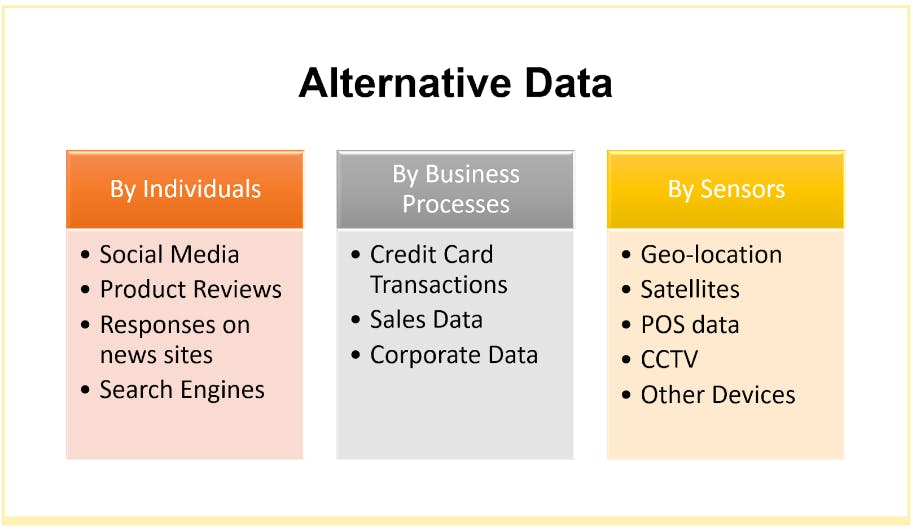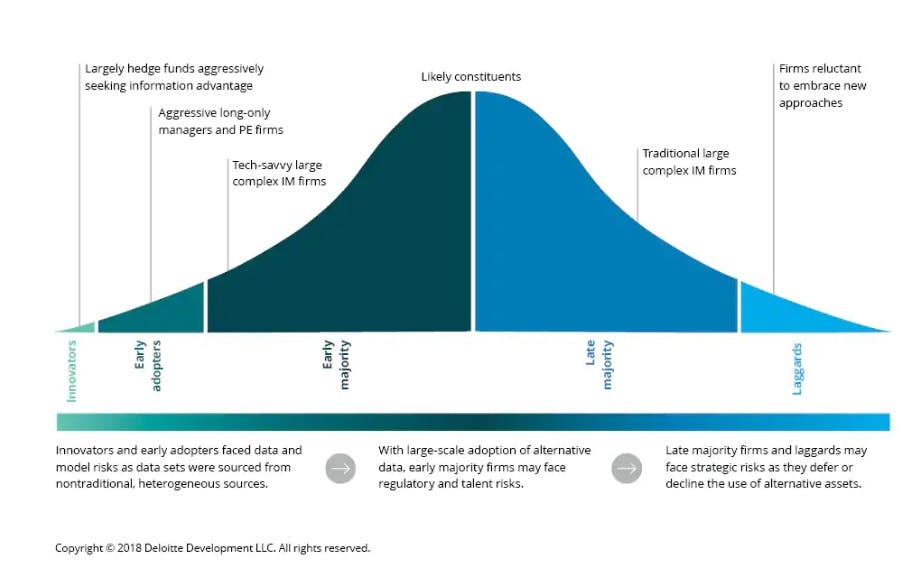The ultimate guide to People and Company alternative data
Alternative data guide for People and Company
Table of Content
What is Alternative Data
Who uses Alternative Data?
- How Alternative data is Generated?
- Web Usage
- Geo-Location Data
- Social Sentiment
- The different types of Alternative Data generation processes
- By individuals (People)
- By Businesses (Company)
- By Sensors
- How Alternative data can be used
- How to guide People and Company Alternative Data
- Conclusion
What is Alternative Data?
Alternative data is the “alternative” to information gathered from traditional data sources. It can also be defined as gaining popularity among hedge fund managers and financial institutions these days. Despite the fact that it opens up new layers of challenges and complexities in the asset selection process, alternative data does give new promises and excitement to the otherwise trying active investing scene.
Alternative Data can also be called Tradition Data Source which means it is a non-traditional data source. Traditional data sources like financial statements, presentations, SEC filings, sales figures, etc., though valuable, don’t usually give a complete and sufficiently timely picture. Investors of this data-driven era are demanding more actionable insights before making inferences about where to invest, but there should be a guide for people and Companies about Alternative Data. Alternative data gives people and companies a set of unique and timely insights to help identify the best investment opportunities. These insights, properly extracted, predict events way before you learn about them from popular financial news outlets.
In contrast, alternative data comes from external sources. As you can likely imagine, any data not coming directly from the company or People issuing the security is an extensive and diverse data set
Who uses Alternative Data?
The use of Alternative Data in companies and for people is increasing. Both are fundamental and quantitative investments, Talking about Companies that will be either a finance or stock exchange company using it to find novel sources of alpha and for the people will be for security reasons or personal development or for research.
In the present time, alternative data has become easier to store and access, in which there is low cost because more companies that have can analyze data which has led to acceptance in many areas of finance beyond hedge funds.
Specifically, alternative data has begun to be adopted in the fields of private equity-like people's personal research work or projects, underwriting, and insurance, to mention a few, The use of alternative data is becoming more best in decision-making at different corporations such as Google, Facebook, and Amazon.
The different types of Alternative Data generation processes

By Individuals (People)
Most of the data generated by individuals tends to be unstructured and comparatively tougher to process. Individuals produce humongous amounts of data every minute. Some of the data created include social media interactions, product reviews on Amazon or other e-commerce groups, as well as trends on search engines like Google, Bing, etc.
By Business Processes(Company):
Most data generated by businesses tend to be structured and can provide great insights for financial decision-making. This form of alternative data is also called ‘exhaust data’, as it mainly comes in the form of a by-product of different business processes. Some of the alternative data created include credit card transactions, sales transactions, and data from government agencies.
By Sensors:
The data that is generated by sensors is largely unstructured. In the current era of technology and the Internet of Things, sensors are widespread. They are continually picking up signals and transporting them from one device to another. Devices like CCTV, machines, POS systems, and even parking lot sensors provide a host of vital business data. Alternative data can also be generated by satellite imaging and geo-location devices. This form of data is highly valuable to gauge things like how often a certain store is visited or how often certain products are being shipped to certain locations.
How Alternative data is Generated?
The image below shows how alternative data is generated
 Let’s take a closer look at some of the different types of alternative data generated:
Let’s take a closer look at some of the different types of alternative data generated:
Web Data Usage
This type of data includes information relating to web traffic, popular web searches, demographics, click-through rates, etc. This type of data is quite useful in gauging the results of advertising campaigns or the popularity of websites or products. It also provides excellent insights for market research and e-commerce.
Geo-location Data
The data received from electronic devices (especially mobile ones) used to track their physical location is called Geo-location data. Other than GPS signals, this type of data is also received from WiFi or Bluetooth signals. This type of alternative data gives a significant amount of information for making location-based decisions. So, organizations can get a better understanding of which locations have the most demand for certain products or activities. Retail stores can use this information to decide the best areas to expand their business. As the Internet of Things technology expands, this form of alternative data will become more and more useful.
Social Sentiment
This includes data resulting from the processing of social media posts and comments. This also includes public reactions to the news, product ads, etc. The data can come in the form of textual posts, digital images, or videos. This can also include any form of online interaction between people on social media sites, like Twitter, Facebook, LinkedIn, etc. This data helps get an idea of current trends and brand virality.
For example, Twitter sentiment analysis is a popular method of gauging public reactions to a product release, event, or public announcement. Most of this data tends to be unstructured and requires pre-processing.
How Alternative data can be used
One thing is for sure:
The use of alternative data in finance and investing is increasing. Both fundamental and quantitative investment firms are using it to find novel sources of alpha.
These businesses use alternative data in different formats and from different sources. For instance, businesses like Orbital Insight continuously track over 260,000 parking spaces using satellite images and then market the data to provide information on when and where people go shopping. These graphics also aid in forecasting when seasonal buying trends are most likely to peak. Investors may be able to anticipate sales revenues using this information far in advance of quarterly returns.

The ability to harvest user content from social media platforms like Facebook and Twitter is another well-known fact. To aid in the web scraping process, they even offer their own APIs. Sentiment analysis can then be done on this data. In reality, a lot of people utilize Twitter sentiment analysis to learn what the general public thinks about certain businesses, occasions, or popular subjects.
Conclusion
The new oil is being referred to as alternative data. Alternative data can provide the insights to advise investors and hedge funds in the direction of fresh approaches to increase alpha. Despite the fact that the field is very young, it is quickly growing in popularity. Finding new method's to process the vast amounts of gathered alternative data will require more research. How to incorporate this data into investment decisions also needs to take into account more recent tactics. The value of this will be immeasurable in twenty years, and for the time being, the potential applications of this new trend are just fascinating to the wondering minds.
